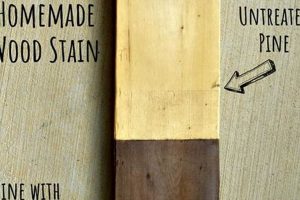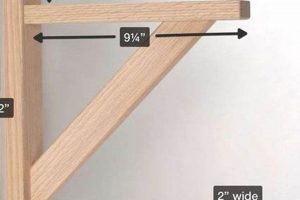A self-constructed climbing aid, typically crafted from timber, allows access to elevated areas. This type of structure often features two parallel side rails joined by evenly spaced rungs or steps. An example includes a homeowner building a ladder to reach the attic or to complete exterior house repairs.
The creation of a personalized climbing device provides cost savings compared to purchasing a manufactured product. It allows for customization in dimensions and materials, ensuring suitability for specific tasks and spaces. Historically, such constructions were essential tools for agriculture, construction, and household maintenance, reflecting resourcefulness and self-sufficiency.
Subsequent sections will address the planning and design considerations, necessary materials and tools, step-by-step construction process, and essential safety precautions for creating a structurally sound and reliable access solution.
Construction Advice for Timber Climbing Structures
The following guidelines offer essential advice for creating a robust and safe wooden ladder for various applications.
Tip 1: Select Appropriate Timber: Use hardwoods like oak or maple for rungs due to their strength. Softwoods such as pine may be suitable for side rails if properly sized and treated, but avoid woods with knots or imperfections.
Tip 2: Plan Dimensions Carefully: Determine the necessary height and width before cutting any lumber. Ensure the rung spacing allows for comfortable and safe climbing, typically between 10 and 12 inches.
Tip 3: Employ Accurate Joinery: Mortise and tenon joints offer superior strength and stability for rung attachment compared to simple nailing or screwing. Ensure a tight fit and use appropriate wood glue.
Tip 4: Reinforce Key Stress Points: Consider adding gussets or braces at critical points where the rungs connect to the side rails. This will increase the load-bearing capacity and prevent premature failure.
Tip 5: Apply a Protective Finish: Use a sealant or exterior-grade paint to protect the wood from moisture and UV damage, extending the lifespan of the structure.
Tip 6: Thoroughly Inspect Before Each Use: Before ascending, examine all joints and structural components for signs of wear, damage, or loosening. Replace any compromised parts immediately.
Adhering to these tips enhances the safety and durability of the resulting structure, promoting secure access to elevated areas.
The next section will provide guidance on maintaining the long-term integrity of a handcrafted wooden ladder.
1. Material Selection
Material selection critically impacts the safety, durability, and longevity of a self-constructed wooden ladder. The chosen wood species dictates the structural integrity, resistance to environmental factors, and overall performance of the ladder. For example, using a knot-ridden softwood will inevitably lead to structural weakness and potential failure under load, contrasting sharply with the stability offered by a clear, straight-grained hardwood. Poor material selection constitutes a significant cause of ladder-related accidents.
The practical significance of understanding wood properties lies in ensuring the ladder’s intended use aligns with its construction. A ladder built for occasional light use in a dry indoor environment can tolerate softer, less expensive woods. However, a ladder intended for frequent outdoor use or heavy loads requires hardwoods treated for weather resistance, such as pressure-treated lumber or naturally rot-resistant species like cedar or redwood. Failure to consider these factors can lead to premature decay, warping, and compromised structural integrity.
Therefore, informed material selection is a prerequisite for safe and effective wooden ladder construction. It involves a thorough understanding of wood species characteristics, load requirements, and environmental conditions. Ignoring this aspect introduces substantial risk and reduces the long-term utility of the finished product. Choosing appropriate materials is an investment in safety and durability.
2. Structural Design
The structural design directly determines a wooden ladder’s load-bearing capacity, stability, and overall safety. Incorrect design parameters, such as insufficient rung spacing or inadequate side rail dimensions, can lead to structural failure, resulting in accidents and injuries. For instance, a ladder with excessively wide rung spacing may cause instability, particularly for users with shorter statures. Similarly, undersized side rails may buckle or break under heavier loads, posing a significant safety hazard.
A fundamental aspect of structural design involves understanding the principles of load distribution and stress concentration. A well-designed ladder distributes the user’s weight evenly across the rungs and side rails, minimizing stress at any single point. Conversely, a poorly designed ladder may concentrate stress at weak points, such as joints or areas with knots in the wood, leading to premature failure. Consider the example of a step ladder: its A-frame design inherently provides more stability and weight distribution than a straight ladder of similar dimensions.
Effective structural design requires adherence to established engineering principles and safety standards. Factors such as ladder height, intended load, and anticipated usage environment must be considered when determining the appropriate dimensions and materials. A comprehensive understanding of these principles is paramount to ensuring the finished ladder provides a safe and reliable means of access. Therefore, meticulous planning and careful execution of the structural design are essential for any wooden ladder construction project.
3. Joint Strength
Joint strength is a paramount consideration in the construction of a wooden ladder. It directly influences the structural integrity, stability, and, consequently, the safety of the completed apparatus. A weak or improperly executed joint can lead to catastrophic failure under load, rendering the ladder unusable and potentially causing serious injury.
- Type of Joint
Different joint types offer varying degrees of strength and suitability for ladder construction. Mortise and tenon joints, for example, provide a robust mechanical interlock between ladder rungs and side rails, distributing load effectively. Lap joints, while simpler to execute, may require additional reinforcement to achieve comparable strength. Dowel joints represent another viable option when executed with precision and employing high-quality adhesives. The choice of joint should align with the intended load and frequency of use.
- Adhesive Selection
The adhesive used in conjunction with mechanical joints significantly contributes to overall joint strength. Exterior-grade wood glues, specifically formulated for moisture resistance and high shear strength, are essential for ladders exposed to the elements. Epoxy resins offer superior bond strength and gap-filling capabilities, making them suitable for demanding applications. The selected adhesive must be compatible with the wood species employed and applied according to manufacturer instructions to achieve optimal results.
- Joint Execution
Precise execution of the chosen joint is crucial for maximizing its strength. Accurate measurements, tight-fitting components, and proper clamping during adhesive curing are essential. Gaps or imperfections in the joint reduce the contact area and weaken the bond. The use of jigs and fixtures can aid in achieving consistent and accurate joint execution, particularly for repetitive tasks such as rung attachment.
- Reinforcement Techniques
In situations where maximum joint strength is required, supplementary reinforcement techniques can be employed. These may include the addition of metal fasteners, such as screws or bolts, to augment the mechanical interlock. Gussets or corner braces can also be incorporated to distribute stress and prevent joint deformation under load. The choice of reinforcement technique should be based on a careful assessment of the ladder’s intended use and potential stress concentrations.
In summary, joint strength is not simply a matter of aesthetics but a critical factor ensuring the structural integrity of a wooden ladder. Thoughtful selection of joint types, appropriate adhesives, precise execution, and strategic reinforcement techniques are essential for creating a safe and durable climbing aid. Neglecting these considerations compromises the ladder’s reliability and increases the risk of accidents.
4. Load Capacity
Load capacity, in the context of a wooden ladder constructed by a non-professional, represents the maximum weight that the structure can safely support without risk of failure. This is not merely a theoretical value but a critical safety parameter directly influencing the well-being of the user. The effects of exceeding the established load capacity range from minor structural damage to catastrophic collapse, both presenting significant risks of injury. An example includes a ladder built with insufficient rung support buckling under the weight of a painter and their equipment, leading to a fall. The importance of accurately determining load capacity resides in mitigating such potential hazards and ensuring a safe working environment.
Several factors contribute to the load capacity of a self-built wooden ladder, including the type and quality of wood, the dimensions of the side rails and rungs, the joinery techniques employed, and the presence of any defects in the materials. For instance, using a softwood like pine for the side rails, instead of a hardwood like oak, inherently reduces the ladder’s ability to withstand heavy loads. Similarly, inadequately secured rungs or poorly executed joints create weak points that compromise the overall structural integrity. The practical application of this understanding manifests in the careful selection of materials and the meticulous execution of construction techniques to maximize load-bearing capabilities.
Accurately estimating the load capacity presents a challenge, as it requires a comprehensive understanding of structural mechanics and material properties. While precise calculations may necessitate engineering expertise, adhering to established guidelines and safety standards provides a reasonable approach for amateur builders. The long-term viability and safety of a handcrafted wooden ladder depend on a realistic assessment and strict adherence to its load capacity. Failure to do so negates the cost savings and customization benefits, replacing them with unacceptable safety risks.
5. Surface Treatment
Surface treatment constitutes a critical phase in the construction of a wooden ladder, directly impacting its longevity and safety. Untreated wood is vulnerable to environmental degradation, insect infestation, and mechanical wear, all of which compromise structural integrity. For example, exposure to moisture without appropriate sealing encourages rot and fungal growth, progressively weakening the wood fibers and increasing the risk of ladder failure under load. Conversely, a properly treated surface provides a barrier against these detrimental effects, significantly extending the service life of the ladder.
The selection of an appropriate surface treatment depends on several factors, including the intended use environment and the type of wood. Ladders used outdoors require treatments offering robust protection against UV radiation, rain, and temperature fluctuations. Preservatives, stains, and sealants are commonly employed, each with specific advantages and disadvantages. Pressure-treated lumber, for instance, offers long-term protection against rot and insect damage but requires careful handling due to the chemicals involved. Alternatively, applying multiple coats of exterior-grade paint or varnish creates a durable, weather-resistant barrier. The application method is also crucial; thorough coverage and proper drying times are essential to achieving optimal protection.
Effective surface treatment represents a proactive approach to maintaining the safety and reliability of a wooden ladder. It safeguards against premature deterioration, preserving the structural integrity of the wood and minimizing the risk of accidents. While surface treatment adds to the initial construction effort, the long-term benefits outweigh the costs, ensuring a durable and safe climbing aid. The knowledge of appropriate surface treatment methods is essential for any individual undertaking the construction of a wooden ladder.
6. Safety Measures
The integration of rigorous safety measures represents a non-negotiable element in the planning, construction, and utilization of a self-constructed wooden ladder. A deviation from established safety protocols directly elevates the risk of accidents, potentially resulting in severe injuries. Inadequate safety precautions during the construction phase, such as failing to wear appropriate personal protective equipment (PPE) like safety glasses or gloves, can lead to lacerations, splinters, or chemical exposures from wood treatments. Subsequently, improper use of the finished ladder, disregarding weight limits or neglecting to ensure a stable base, increases the likelihood of falls. Prioritizing safety measures, therefore, serves as a proactive approach to minimizing potential hazards throughout the ladder’s lifecycle.
Implementing specific safety measures at each stage of the process mitigates identifiable risks. For example, selecting straight-grained, knot-free lumber reduces the probability of structural failure. Securely fastening rungs to side rails using robust joinery techniques and high-quality adhesives prevents component separation under load. Thoroughly inspecting the ladder before each use allows for the detection and correction of any developing issues, such as loose rungs or cracks in the wood. Providing clear instructions and limitations regarding the ladder’s intended use, including maximum weight capacity and appropriate leaning angles, ensures that users understand the safety parameters. These measures collectively contribute to a safer and more reliable access solution.
In conclusion, safety measures are not optional additions but rather integral components of a self-constructed wooden ladder. Adherence to recognized safety practices, from material selection and construction techniques to inspection and utilization protocols, directly influences the structural integrity and overall safety of the ladder. While the initial investment in time and resources dedicated to safety may seem significant, it pales in comparison to the potential consequences of neglecting these crucial aspects. A commitment to safety ensures that the ladder serves its intended purpose effectively and without compromising the well-being of its users.
Frequently Asked Questions
The following addresses common inquiries regarding the construction of wooden ladders, providing clarity and guidance on essential aspects of the process.
Question 1: What is the most crucial aspect to consider when undertaking a wooden ladder project?
Safety is the paramount consideration. Every decision, from material selection to construction technique, must prioritize minimizing the risk of accidents and ensuring the ladder’s structural integrity.
Question 2: Which wood species are most suitable for building a load-bearing ladder?
Hardwoods like oak, maple, and ash offer superior strength and durability compared to softwoods. Properly treated softwoods, such as Douglas fir, may be acceptable for lighter-duty applications, but careful consideration of load requirements is essential.
Question 3: What type of joint is recommended for connecting rungs to the side rails?
Mortise and tenon joints, secured with high-quality adhesive, provide the most robust and reliable connection. Dowel joints and lap joints, when properly executed and reinforced, can also offer adequate strength.
Question 4: How can the load capacity of a homemade wooden ladder be determined?
A precise calculation requires engineering expertise. However, adhering to established safety guidelines and over-engineering the structure using robust materials and joinery techniques can provide a reasonable safety margin. Always err on the side of caution.
Question 5: Is surface treatment necessary for a wooden ladder used exclusively indoors?
While indoor environments are less harsh than outdoor settings, surface treatment is still advisable. It protects against moisture absorption, insect infestation, and general wear and tear, prolonging the ladder’s lifespan.
Question 6: What are the key points to inspect before each use of a self-built wooden ladder?
Thoroughly examine all joints for looseness or damage. Inspect the side rails and rungs for cracks, splits, or signs of decay. Ensure that the ladder is placed on a stable and level surface before ascending.
In summary, the construction of a wooden ladder demands careful planning, precise execution, and unwavering adherence to safety protocols. A thorough understanding of materials, joinery techniques, and load capacity is essential for creating a safe and reliable climbing aid.
The subsequent section will explore the maintenance and repair procedures necessary for ensuring the long-term functionality and safety of a handcrafted wooden ladder.
DIY Wooden Ladder
This exploration has emphasized the critical considerations inherent in the creation of a do-it-yourself timber climbing apparatus. Material selection, structural design, joint integrity, load-bearing capacity, and protective surface treatments all contribute to the safety and longevity of the resulting structure. A failure to adequately address any of these facets can lead to premature degradation or, more seriously, structural collapse and potential injury.
The decision to construct a climbing device independently warrants careful deliberation. While potential cost savings and customization benefits may be attractive, the project demands a thorough understanding of structural principles and a commitment to rigorous safety practices. Those without the requisite skills or resources should carefully weigh the risks before proceeding, understanding that the long-term well-being of the user should always be prioritized above economic considerations.







